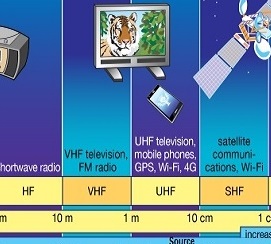Many hams equate frequencies and bands with colloquial usage. Therefore VHF is 2 meters, specifically 144 to 148 MHz, and HF is 160 through 6 meters, just like on our HF radios.
Oops. VHF refers to Very High Frequency, and is a chunk of radio spectrum from 30 to 300 MHz- all inclusive. That places 6 meters, 2 meters and the 220 MHz band all in VHF. Therefore, 6 meters is NOT an HF band.
OK, then 160 through 10! –Nope-. Technically, the bands within 300 kHz to 3 MHz are Medium Frequency, or MF bands. Since 1.8 to 2 MHz falls squarely within this range, 160 meters is an MF band- NOT HF.
The International Telecommunications Union (ITU) radio bands are designations defined in the ITU Radio Regulations. Article 2, provision No. 2.1, states that “the radio spectrum shall be subdivided into nine frequency bands, which shall be designated by progressive whole numbers in accordance with the following table.”
VLF: Very Low Frequency; 3 to 30 kHz, 10 to 100 km wavelength
LF: Low Frequency; 30 to 300 kHz, 1 to 10 km wavelength
MF: Medium Frequency; 300 to 3000 kHz, 100 to 1000 m wavelength
HF: High Frequency; 3 to 30 MHz, 10 to 100 m wavelength
VHF: Very High Frequency; 30 to 300 MHz, 1 to 10 m wavelength
UHF: Ultra High Frequency; 300 to 3000 MHz, 10 to 100 cm wavelength
SHF: Super High Frequency; 3 to 30 GHz, 1 to 10 cm wavelength
EHF: Extremely High Frequency; 30 to 300 GHz, 1 to 10 mm wavelength
THF: Tremendously High Frequency; 300 to 3000 GHz, 0.1 to 1 mm wavelength
There are the radio bands in a nutshell. So, where does 70cm fit in? UHF, of course! It’s there, along with 33cm, 23cm and 2.4 GHz (12.5cm).
Simple, isn’t it? So, memorize it for a test next Monday.



Pingback: URL